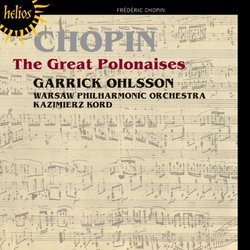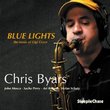(+) Chopin's Mature Polonaises Played as Nostalgic Tone Poem
C. Pontus T. | SE/Asia | 01/22/2010
(4 out of 5 stars)
"Due to Chopin's unparalleled understanding of the piano, none of his music is easy to play--or rather to play well that is. What makes the Polonaises particularly difficult is their combination of innate rhythmic rigidity, vast elements of fantasy, and densely textured piano figurations. Additionally, they vary greatly in character and scope--meaning a successful approach to one could be detrimental to another.
Therefore, I have not encountered an altogether distinguished account of all 17 Polonaises (4 juvenile, 5 semi-mature, 8 mature). Of the 8 mature, included on this disc, there are 'two odd miis out'--the unusually virtuosic Grande Polonaise with orchestra, prefaced by the dreamy Andante spianato, and the supreme masterpiece Polonaise-Fantaisie. These two works also show the fundamental difference between two of the greatest Chopin interpreters--Argerich and Ohlsson: Argerich's spontaneous virtuosity is one of a kind in the Grande Polonaise (8:29), whereas her similar approach to the Polonaise-Fantaisie (11:30) sounds rushed and shallow; Ohlsson's Grande Polonaise (9:30) is tame and obedient, whereas his Polonaise-Fantaisie (14:20) conjures up an entire fantasy world.
Ohlsson's Op 26/1 is ideal in framing the stiff, martial court dance around the lush, dreamy middle section. His 'Siberian' Op 26/2 is as chilly as Ashkenazy's, if not quite ice cold as Pollini's; my preferred version in this dark piece (one of Chopin's most depressive) is Harasiewicz's with quicker pacing and lighter characterisation. The dualistic Op 40 has never come off as widely contrasted as here--the 'Military' A major being more lilting than march-like (a bit like a guerilla army!) and without all the unnecessary repeats, and the great C minor being a profoundly nostalgic elegy. Op 44 has received several good performances, from Harasiewicz and Ashkenazy, and some great from Pogorelich and Kissin; Ohlsson's beautifully balanced performance joins the latter (together with his 1972 account on EMI). However, Ohlsson's delicate playing cannot quite convince one of the heroic aspects of Op 53--Askhenazy and, again, above all Argerich are far more convincing.
As thankful as I am for this Helios reissue, I would rather have seen the inclusion of the Op 49 Fantaisie than the orchestral version of the Grand Polonaise, which Ohlsson frankly turns into merely a pleasant Sunday morning walk--with good help from the Warsaw Philharmonic under Kazimierz Kord. After all, this F-minor masterpiece is the closest there is of a bedfellow to the sublime Polonaise-Fantaisie, and Ohlsson's rendition is predictably fantastic. Moreover, I still would not want to be without the five 'semi-mature' Polonaises (Op 71/1-3, B-flat minor, G-flat major) as well as the stupendously auspicious G-sharp-minor piece written in 1822 at only 12 years of age. Hence, the prime recommendation remains the original Arabesque incarnation of the 16 solo Polonaises--even if Ohlsson's 1972 traversal is competitive indeed when taking the price tag into account (reissued on EMI Gemini in 2006). Next out is the Preludes & Impromptus (Helios CDH55383).
REFERENCES: This One, Argerich (Op 22 & Op 53)"





